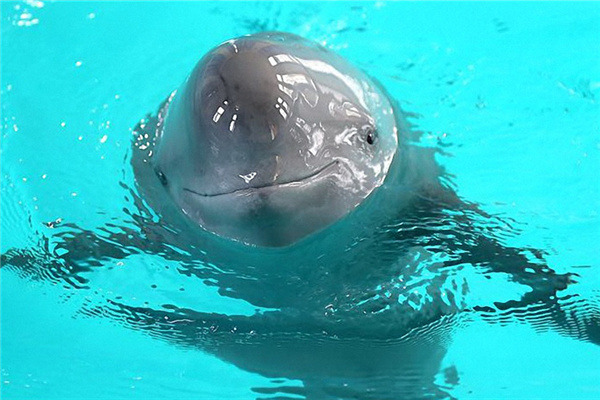
A captive finless porpoise swims in an aquarium in the Chinese Academy of Sciences' Institute of Hydrobiology in Wuhan, Hubei province, last year. (Photo/Xinhua)
A scientific survey on the Yangtze River to review the status of the endangered finless porpoise was launched in Wuhan, Hubei province, on Friday. Its findings are expected to be released in March.
Financed by World Wildlife Fund and local foundations in the province, the survey is the third to be undertaken by the Ministry of Agriculture since 2006. It is being led by the Chinese Academy of Sciences' Institute of Hydrobiology.
"Allowing for the decline in porpoise's population and distribution, the survey can show variations more accurately if carried out every five to six years," said Hao Yujiang, a researcher at the institute who is in charge of the work.
The survey will cover waters along the middle and lower stretches of the Yangtze and its two connecting lakes - Poyang and Dongting.
"We will calculate population and distribution of the finless porpoise in the survey and evaluate the environment in which they live. Information we gather will be used to help the government determine key protection areas and take targeted protection measures."
The 3,400-kilometer round trip will last about 40 days, with 32 members and volunteers from research institutes and NGOs involved.
Surveys along the river will conclude on Dec 20, while work at Poyang and Dongting lakes will start on Dec 25 and finish on Jan 10, said Wang Ding, another hydrobiology researcher.
Methods used in the survey include visual observation, acoustic and underwater noise detection and references to the surveys in 2006 and 2012, Wang said, adding that water samples, sediment and underwater noise data will be collected every 50 kilometers.
Team leader Hao said that drones will be used for the first time in the survey to monitor the porpoises and their habitat.
"Visual observation is a recognized method used in wildlife observation," Hao said. "We have seven members observing the porpoises on each of our two ships. Visual fatigue is an inevitable element that will affect the survey results. Drones, however, will help us to correct the results."
The population of the finless porpoise has seen a sharp decline in the past six years - 13.7 percent. The 2012 survey found 1,045 porpoises in the river, about half the number researchers calculated in 2006, Hao said.
Water pollution, environmental degradation and an inefficient food chain - the result of illegal and unregulated fishing activities - are thought to be the reason for the dramatic decline of the species.
Li Yanliang, chairman of National Aquatic Wildlife Conservation Association, said: "About 10 years ago, the Baiji dolphin was declared functionally extinct. Now the population of finless porpoise is nearly half that of the panda. Protecting the porpoises is a pressing task for us."


















































